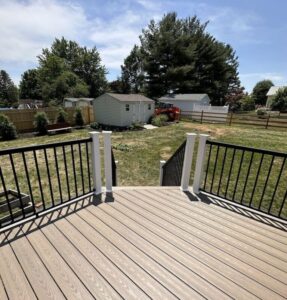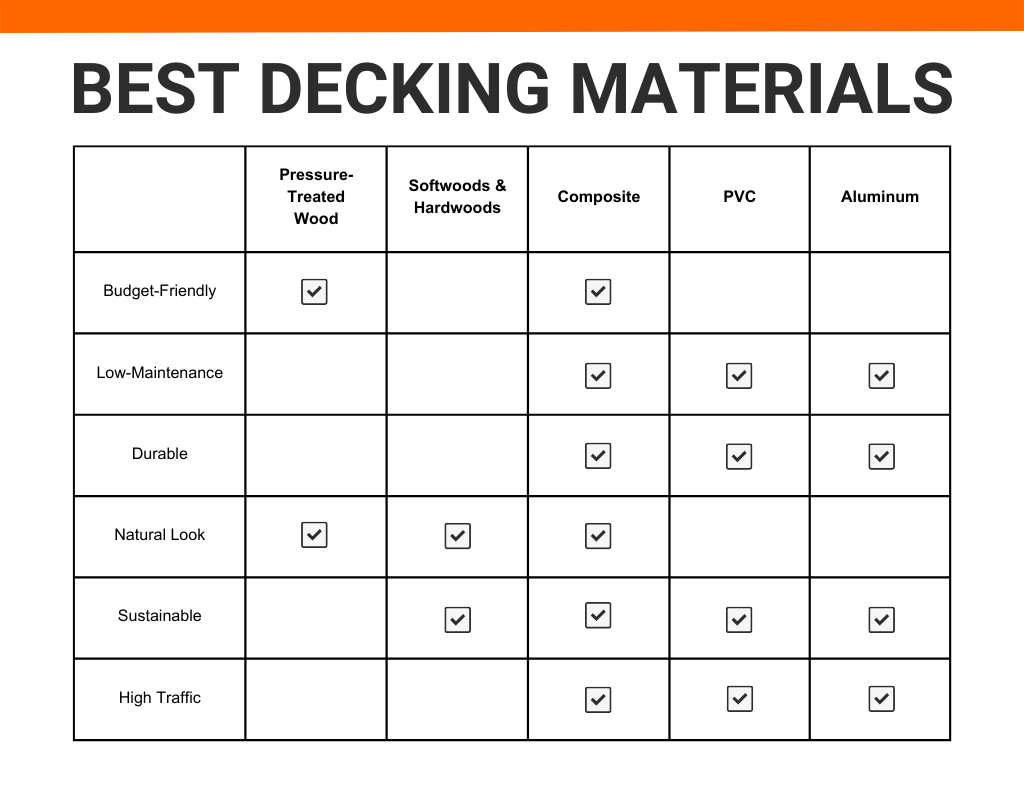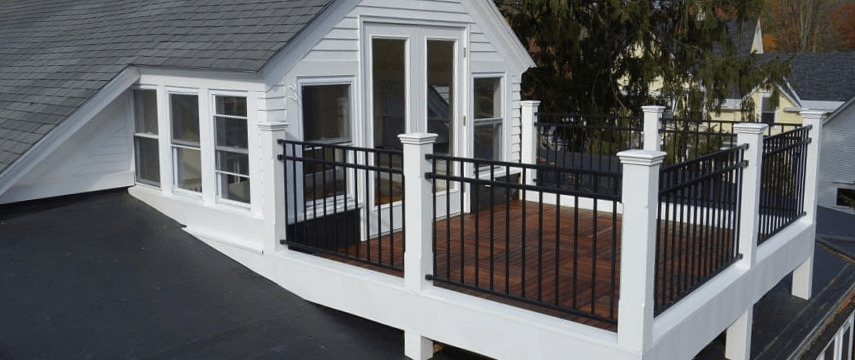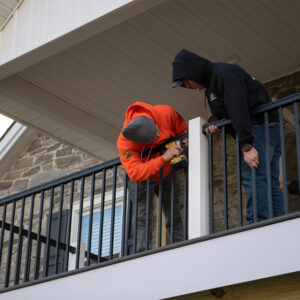When you think of your dream deck, what do you picture? Maybe you’re lounging in a chair on a summer evening, sipping your favorite beverage. Or maybe you’re curled up in the shade under a covered balcony. Whatever your vision, your decking material makes a big difference. Today we’ll break down the best decking materials so you can choose which is right for you.
Why Material Matters
Your decking material can make or break a project. As a Pennsylvania homeowner, your deck needs to withstand sun, snow, and storm damage. And if it’s near a body of water, then it also needs to handle excessive moisture.
The option you choose affects your deck’s lifespan, total cost, appearance, and return on investment. Certain materials are more durable, but they also have a higher upfront cost. However, you may save money in the long run by avoiding the price of repairs for their higher-maintenance counterparts.
You also have to think about aesthetics. Some materials, like traditional wood decks, have a natural look. Vinyl decks, on the other hand, often look more modern. To find the best decking materials, you need to decide what aspect you prioritize the most.
The Best Decking Materials
Pressure-Treated Wood
Wood is a classic choice for a deck. Pressure-treated wood (typically pine) is flooded with preservatives, water repellents, and other chemicals using a pressure chamber. Despite this extra seal of protection, nothing can keep out the elements completely.
Over time, pressure-treated wood tends to crack, rot, and warp. This is where maintenance comes in. The biggest drawback of traditional wood decks is that they need to be sanded and stained every three years. In addition, you should reseal your deck every 1-3 years.
However, no amount of maintenance can make wood last forever. Because of this, pressure-treated wood doesn’t offer much long-term value. While it’s a cost-effective option upfront, the price of annual repairs will add up.
Pros of Pressure-Treated Wood:
- Classic, natural look
- Inexpensive upfront
- Some protection against mold and insects
- Can be stained or painted in any color
Cons of Pressure-Treated Wood:
- High maintenance
- Can develop a green tint if not resealed properly
- Need to follow safety measures when handling it because of the chemical treatment
- May splinter and crack over time
Softwoods
Softwoods are—you guessed it—soft! This means they can be damaged by foot traffic and are prone to dents and scratches. The most common softwoods to use for decking are cedar and redwood. These species have similar properties, but redwood is denser and better for high-traffic areas.
Softwoods also don’t offer much value in the long run. Just like homes, they require consistent upkeep to maintain their appearance. Eventually, the organic material will deteriorate. This decay will be sped along in areas with lots of moisture and limited sunlight (like a shaded porch).
Pros of Softwoods:
- Classic, natural look
- Inexpensive (but a step up from pressure-treated)
- Strong material
- Naturally insect and rot resistant
- Can be stained or painted in any color
Cons of Softwoods:
- High maintenance
- Will lose color without regular upkeep
- Prone to dents and scratches
- Deteriorates over time
Tropical Hardwoods
If you’re looking for a more durable option, tropical hardwoods are a solid choice. Typically tigerwood or ipe, these species are dense and hard with rich colors. They are less likely to dent and crack, but they are also difficult to work with. The material is so hard you can’t even hammer in a nail without drilling a hole first.
Despite their durability, hardwoods are not fully resistant to weather. Just like the others, they require staining and sealing every few years to maintain the protection a deck needs.
Pros of Tropical Hardwoods:
- Visually appealing (a statement deck)
- Durable and scratch resistant
- Less likely to crack than other wood materials
- Strong
- Can be stained or painted in any color
Cons of Tropical Hardwoods:
- Most expensive wood option
- High maintenance
- Will turn gray with prolonged sun exposure
- Deteriorates over time
- Harder to work with
Composite

Composite decking materials have the natural look of wood without the high maintenance. They’re made of a blend of recycled plastic and wood fibers, so you don’t have to worry about painting or finishing the material. However, they are less resistant to mildew and stains.
There are two types of composite decking materials: capped and uncapped. Capped composite includes an extra protective coating made of water-resistant polymers that is sealed on all edges. If you’re wondering what deck has less maintenance but high performance? Capped composite decking is your answer.
Pros of Composite:
- Won’t splinter or crack
- Lower maintenance
- More durable than wood (can last 25+ years)
- Easiest to install
Cons of Composite:
- More expensive than wood
- Heavier material
- Requires periodic scrubbing to avoid mildew
- Not as strong as wood
- Only comes in select colors
PVC
The next category of the best decking materials showdown is vinyl. The most common type is PVC (polyvinyl chloride). Since it’s completely synthetic, PVC avoids some of the pitfalls of organic materials like moisture damage, mold, and rot.
Vinyl decking has some significant advantages. It doesn’t require staining, it’s highly resistant to the elements, and it can last a lifetime. However, be careful when walking on it barefoot—it can get hot in the sun. Just like composite, PVC decking has the option of a protective cap to increase durability.
Pros of PVC:
- Low maintenance (just the occasional cleaning)
- Doesn’t splinter or crack
- Resistant to insects, dents, and fire
- Long lasting and durable
- Usually recyclable
Cons of PVC:
- More expensive than composite
- Has an artificial, plastic appearance
- May squeak when you walk on the boards
- Gets hot in the sun
Aluminum
While aluminum decking is not very common, it actually makes a great decking material! It will last a lifetime and is resistant to pests and mold. It also provides good traction underfoot so you don’t have to worry about slipping. However, aluminum decks can be noisy and hot.
Pros of Aluminum:
- Durable and long lasting
- Low maintenance
- Good traction
- Lightweight
Cons of Aluminum:
- Most expensive option
- Gets hot in the sun
- Noisy
- Lacks the natural look of wood
- Less popular
What to Consider When Choosing a Decking Material
Now that you know the pros and cons of the best decking materials, it’s time to pick one for your project. There are several factors to consider when deciding:
- Budget — how much are you willing to spend on your new deck?
- Maintenance — how much time can you commit to maintaining and repairing your deck?
- Durability — how long do you want it to last?
- Appearance — what aesthetic look are you going for?
- Sustainability — are your materials recyclable?
- Intended Use — where will you build your deck and how much foot traffic will it get?

How KSW Can Help
Ready to get started on your dream deck? Contact our team today! We offer ramp and deck building services so you can enjoy the outdoors in style. Once you reach out, we’ll learn about your vision and begin working with our designer to bring your outdoor space to life.
From there, we’ll give you a full estimate with a cost breakdown of different design options. With these details, you’ll be able to decide on the best decking material for your project. Need some inspiration? Check out our gallery of our favorite deck installations so far.
Deck Styles:
- Open decks
- Covered decks
- Ground level decks
- Elevated decks
- ADA-compliant decks with ramps and railings
No matter your vision or budget, we can install your deck in no time!


